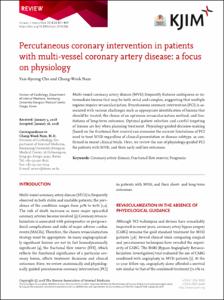KUMEL Repository
1. Journal Papers (연구논문)
1. School of Medicine (의과대학)
Dept. of Internal Medicine (내과학)
Percutaneous coronary intervention in patients with multi-vessel coronary artery disease: a focus on physiology
- Keimyung Author(s)
- Cho, Yun Kyeong; Nam, Chang Wook
- Department
- Dept. of Internal Medicine (내과학)
- Journal Title
- Korean J Intern Med.
- Issued Date
- 2018
- Volume
- 33
- Issue
- 5
- Abstract
- Multi-vessel coronary artery disease (MVD) frequently features ambiguous or intermediate lesions that may be both serial and complex, suggesting that multiple regions require revascularization. Percutaneous coronary intervention (PCI) is associated with various challenges such as appropriate identification of lesions that should be treated, the choice of an optimum revascularization method, and limitations of long-term outcomes. Optimal patient selection and careful targeting of lesions are key when planning treatment. Physiology-guided decision-making (based on the fractional flow reserve) can overcome the current limitations of PCI used to treat MVD regardless of clinical presentation or disease subtype, as confirmed in recent clinical trials. Here, we review the use of physiology-guided PCI for patients with MVD, and their early and late outcomes.
- Publisher
- School of Medicine (의과대학)
- Citation
- Yun-Kyeong Cho and Chang-Wook Nam. (2018). Percutaneous coronary intervention in patients with multi-vessel coronary artery disease: a focus on physiology. Korean J Intern Med., 33(5), 851–859. doi: 10.3904/kjim.2018.006
- Type
- Article
- ISSN
- 2005-6648
- Source
- http://kjim.org/journal/view.php?doi=10.3904/kjim.2018.006
- Appears in Collections:
- 1. School of Medicine (의과대학) > Dept. of Internal Medicine (내과학)
- 파일 목록
-
-
Download
 oak-2018-1557.pdf
기타 데이터 / 241.29 kB / Adobe PDF
oak-2018-1557.pdf
기타 데이터 / 241.29 kB / Adobe PDF
-
Items in Repository are protected by copyright, with all rights reserved, unless otherwise indicated.